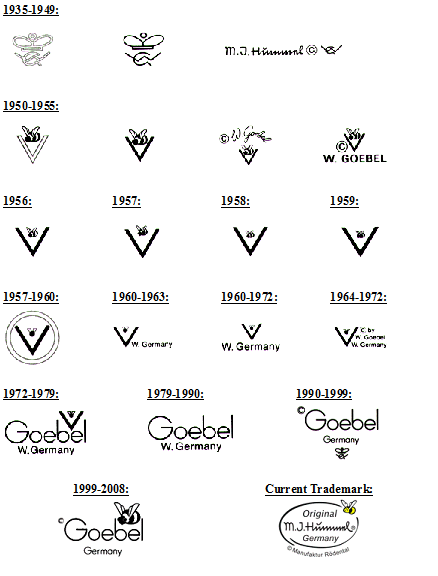Goebel
History of Goebel:
Around 1905 The crown above the monogram “WG” marks the transition of the company to William Goebel in 1893. Germany celebrates its Kaiser era and Goebel is part of it. Luxury porcelain, the dream of many, is also sold in America. In Goebel’s impressive factory, small sculptures in Meissen Rococo style are also created. Animal figurines bring the ambience of nature and the exotic into the living rooms of many, while charming figurines of children bring a smile. Goebel also produces bowls, small censers and much more… always in tune with the lifestyle of the times.
1911 Max Louis Goebel takes over the management of the factory. Educated in the booming metropolis of New York City, he, too, loves art…and knows how to combine this passion with business. Goebel becomes a place of innovations. By the year 1919, the luxury brand “Kunstwerkstätten Wilhelmsfeld” is evidence of this innovative spirit.
1921-1931 The Roaring Twenties make their entry at Goebel. Figurines and design elements in Art Deco style conquer the collection. On the occasion of the company‘s 60th anniversary in 1931, many factory modernizations are announced.
1935 Grandson Franz Goebel also proves to be a man of vision. An exclusive agreement with Sister Maria Innocentia Hummel and the Convent of Siessen grants Goebel the exclusive right to adapt the artist’s drawings into three-dimensional porcelain figurines. The famous Hummel figurines are born and become a “million seller” in America. For many years Goebel has been known as the “Hummelwerk“.
1950 Walt Disney, already famous for his legendary characters, also sits at the negotiating table with Franz Goebel. This is the year that Bambi and her friends enriched the Goebel collection.
1953 Heinz Schaubach hands over to his friend Franz Goebel many of his designs. The “Schaubach-Kunst” becomes part of the Goebel assortment.
1971 Goebel celebrates its 100th anniversary. The highlight of the ceremonies is the unveiling of the larger than lifesize M.I.Hummel “Merry Wanderer“ figure which stands in front of the company building.
1977 The Goebel Collectors‘ Club is founded in the USA, which is the first club of its kind worldwide. This marks a further milestone in Goebel’s success history.
1981 With the “Goebel Galerie” the family-owned company inspires contemporary artists to create new works using porcelain. Unique, exciting pieces are the result of this daring experiment.
1993 Establishment of the business division Gifts and Decorative Accessories. The close cooperation with new artists is continued and the product range enlarged. The foundation stone for today‘s assortment is laid.
2000 By the turn of the millennium, Goebel is one of the most important porcelain brands, with pieces residing in many museums and collections worldwide. Within the following years extensive reorganisations take place which were the consequences of 11 September 2001 and the corresponding market warpings emerging from this.
2006 The principal creditor bank Merrill Lynch refuses the continuation of financing and hence provokes the insolvency of the company.
2007 The business activity of W. Goebel Porzellanfabrik is being continued by Goebel Porzellanmanufaktur GmbH, the shareholders are international investment companies.
2008 Divestment of the M.I. Hummel division. The Hummel figurines are still crafted by hand with loving care by the company Manufaktur Rödental.
2009 Return to the core business with “Gifts and Decorative Accessories” and thus back to the “white gold” (porcelain) for connoisseurs…that is, porcelain for those who want the very best. History becomes present… and future.
2010 Goebel remains a family run business. Since September 1st, 2010 Goebel Porzellan has a new owner, PM Kapital GmbH & Co. KG, Bad Staffelstein. This company has already been active in the ceramic industry for many years and is also shareholder of Kaiser-Porzellan in Bad Staffelstein.
Under the roof of PM Kapital, two companies are now united, both of which have a similarly long history in the ceramic industry of Upper Franconia. Goebel was founded in 1871 and Kaiser Porzellan in 1872. Both companies will, however, maintain their legal independence in the future.
“What comes together, belongs together,” says Hans-Peter Langsch, CEO, who has been with the Goebel company since 1993. He was the one who, at that time, was assigned by Wilhelm Goebel to establish the Gifts and Decorative Accessories division. Both companies are active in almost identical distribution channels, markets and technologies, but differ in their product alignment.
May 2016 The complete administration of Goebel has moved from Roedental to Bad Staffelstein, the Goebel Factory Outlet remains in Roedental. The Goebel Showroom where regional in-house exhibitions and larger meetings take place was in Bad Staffelstein already for some time.
Goebel Today: Goebel, the traditional brand name for gift-giving, collecting and decorating, with its collections Artis Orbis, Pop Art, de luxe*, Nina & Marco, Rosina Wachtmeister and the seasonal lines Easter and Christmas as well as Kaiser Porzellan and NADAL Creationes, Goebel’s world famous brands are poised between tradition and lifestyle, awakening emotions that last for generation.











